Effect of the Drying Method and Storage Conditions on the Quality and Content of Selected Bioactive Compounds of Green Legume Vegetables
Abstract
1. Introduction
2. Results and Discussion
2.1. Effect of Blanching on the Analyzed Parameters
2.2. Effect of Drying and Storage on the Analyzed Parameters
2.2.1. Physical Properties
2.2.2. Contents of Bioactive Components
2.2.3. Sensory Assessment
2.2.4. Principal Component Analysis (PCA)
3. Materials and Methods
3.1. Experimental Material
3.2. Production of Dried Materials
3.3. Methods
3.3.1. Physical Analyses
Preparation of Raw Material for Analyses
Determination of Water Content
Determination of Water Absorption Capacity
Determination of Water Activity
Color Assessment with the Instrumental Method
3.3.2. Chromatographic Analyses
Determination of Vitamin C Content
Determination of Vitamin E Content
3.3.3. Spectrophotometric Analyses
Determination of Contents of Total Chlorophylls and Total Carotenoids
Determination of β-Carotene Content
Determination of Total Polyphenol Content
Determination of Antioxidative Activity against the DPPH Radical
3.3.4. Sensory Assessment
3.3.5. Statistical Analysis
4. Conclusions
Supplementary Materials
Author Contributions
Funding
Institutional Review Board Statement
Informed Consent Statement
Data Availability Statement
Conflicts of Interest
Abbreviations
| vegetable | (B—dried green beans; P—dried green peas) |
| method of drying | (F—freeze-drying; A—air—drying), |
| storage of period | (0, 4, 8, 12 months) |
| temperature of storage | (C—cooling storage 2–4 °C; R—room storage 18–22 °C) |
| NEB | non-enzymatic browning |
| PME | pectin methylesterase |
References
- Lewis, G.P. Legumes of the World; Royal Botanic Gardens, Kew: Richmond, UK, 2005. [Google Scholar]
- Kapusta, F. Rola roślin strączkowych w rolnictwie polskim (The role of legume in Polish agriculture). Zagadnienia Doradz. Rol. 2017, 87, 68–78. (In Polish) [Google Scholar]
- Petropoulos, S.A.; Taofiq, O.; Fernandes, Â.; Tzortzakis, N.; Ciric, A.; Sokovic, M.; Barros, L.; Ferreira, I.C. Bioactive properties of greenhouse-cultivated green beans (Phaseolus vulgaris L.) under biostimulants and water-stress effect. J. Sci. Food Agric. 2019, 99, 6049–6059. [Google Scholar] [CrossRef]
- Los, F.G.B.; Zielinski, A.A.F.; Wojeicchowski, J.P.; Nogueira, A.; Demiate, I.M. Beans (Phaseolus vulgaris L.): Whole seeds with complex chemical composition. Curr. Opin. Food Sci. 2018, 19, 63–71. [Google Scholar] [CrossRef]
- Weidner, S.; Król, A.; Karamać, M.; Amarowicz, R. Phenolic compounds and the antioxidant properties in seeds of green-and yellow-podded bean (Phaseolus vulgaris L.) varieties. CyTA J. Food 2018, 16, 373–380. [Google Scholar] [CrossRef]
- Bustos, A.Y.; Font, G.; Taranto, M.P. Fruits and vegetables snacks as carriers of probiotics and bioactive compounds: A review. Int. J. Food Sci. Technol. 2023, 58, 3211–3223. [Google Scholar] [CrossRef]
- Spagnuolo, A.; Vetromile, C.; Masiello, A.; De Santo, G.; Suriano, M.; Mercuri, G.; Pellegrino, M.; Piccolo, G.; Lubritto, C.; Di Cicco, M.R. Industrial Drying of Fruit and Vegetable Products: Customized Smart Monitoring and Analytical Characterization of Process Variables in the OTTORTO Project. Processes 2023, 11, 1635. [Google Scholar] [CrossRef]
- Boeing, H.; Bechthold, A.; Bub, A.; Ellinger, S.; Haller, D.; Kroke, A.; Leschik-Bonnet, E.; Müller, M.J.; Oberritter, H.; Schulze, M.; et al. Critical review: Vegetables and fruit in the prevention of chronic diseases. Eur. J. Nutr. 2012, 51, 637–663. [Google Scholar] [CrossRef] [PubMed]
- van Breda, S.G.J.; de Kok, T.M.C.M. Smart combinations of bioactive compounds in fruits and vegetables may guide new strategies for personalized prevention of chronic diseases. Mol. Nutr. Food Res. 2018, 62, 1700597. [Google Scholar] [CrossRef] [PubMed]
- Food and Agriculture Organization of the United Nations. Pulses: Nutritious Seeds for a Sustainable Future; FAO: Rome, Italy, 2016. [Google Scholar]
- Vicente, A.R.; Manganaris, G.A.; Ortiz, C.M.; Sozzi, G.O.; Crisosto, C.H. Nutritional Quality of Fruits and Vegetables. In Postharvest Handling: A Systems Approach; Academic Press: Cambridge, MA, USA, 2014; pp. 69–122. [Google Scholar] [CrossRef]
- Jarosz, M.; Wolnicka, K.; Sajór, I.; Wierzejska, R. Zalecenia dotyczące żywienia i aktywności fizycznej (Recommendations regarding nutrition and physical activity). In Normy Żywienia dla Populacji Polskiej (Nutrition Standards for the Polish Population); Jarosz, M., Ed.; Instytut Żywności i Żywienia im. Prof. dra Med. Aleksandra Szczygła: Warsaw, Poland, 2017; pp. 261–283. (In Polish) [Google Scholar]
- Kępka, A.; Ochocińska, A.; Borzym-Kluczyk, M.; Chojnowska, S.; Skorupa, E.; Przychodzeń, M.; Waszkiewicz, N. Healthy Food Pyramid as Well as Physical and Mental Activity in the Prevention of Alzheimer’s Disease. Nutrients 2022, 14, 1534. [Google Scholar] [CrossRef] [PubMed]
- FAO/WHO (Food and Agriculture Organization of the United Nations/World Health Organization). Fruit and Vegetables for Health Initiative. 2017. Available online: http://www.fao.org/3/a-i6807e.pdf (accessed on 20 February 2024).
- Li, M.; Wang, B.; Lv, W.; Zhao, D. Effect of ultrasound pretreatment on the drying kinetics and characteristics of pregelatinized kidney beans based on microwave-assisted drying. Food Chem. 2022, 397, 133806. [Google Scholar] [CrossRef] [PubMed]
- Nurhaslina, C.R.; Andi Bacho, S.; Mustapa, A.N. Review on drying methods for herbal plants. Mater. Today Proc. 2022, 63, S122–S139. [Google Scholar] [CrossRef]
- Bugała, A. Handel zagraniczny suszonymi warzywami w Polsce (Foreign trade of dried vegetables in Poland). PFiOW 2017, 2, 12–14. (In Polish) [Google Scholar] [CrossRef]
- Korus, A. Effect of preliminary processing, method of drying and storage temperature on the level of antioxidants in kale (Brassica oleracea L. var. acephala) leaves. LWT Food Sci. Technol. 2011, 44, 1711–1716. [Google Scholar] [CrossRef]
- Vogelmann, T.C. Light within the plant. In Photomorphogenesis in Plants, 2nd ed.; Kendrick, R.E., Kronenberg, G.H.M., Eds.; Springer: Dodrecht, The Netherlands, 1994. [Google Scholar]
- Gębczyński, P.; Lisiewska, Z. Comparison of the level of selected antioxidative compounds in frozen broccoli produced using traditional and modified methods. Innov. Food Sci. Emerg. Technol. 2006, 7, 239–245. [Google Scholar] [CrossRef]
- Gębczyński, P.; Kmiecik, W. Effects of traditional and modified technology, in the production of frozen cauliflower, on the contents of selected antioxidative compounds. Food Chem. 2007, 101, 229–235. [Google Scholar] [CrossRef]
- Sikora, E.; Cieślik, E.; Leszczyńska, T.; Filipiak-Florkiewicz, A.; Pisulewski, P.M. The antioxidant activity of selected cruciferous vegetables subjected to aquathermal processing. Food Chem. 2008, 107, 55–59. [Google Scholar] [CrossRef]
- Volden, J.; Bengtsson, G.B.; Wicklund, T. Glucosinolates, L-ascorbic acid, total phenols, anthocyanins, antioxidant capacities and colour in cauliflower (Brassica oleracea L. ssp. botrytis); effects of long-term freezer storage. Food Chem. 2009, 112, 967–976. [Google Scholar] [CrossRef]
- Lee, H.L.; Choo, W.S. Effect of storage time on ascorbic acid and total phenolic contents and colour of blanched, boiled and steamed cauliflowers (Brassica oleracea L. ssp. botrytis). Pertanika J. Trop. Agric. Sci. 2019, 42, 535–544. [Google Scholar]
- Baardseth, P.; Bjerke, F.; Martinsen, B.K.; Skrede, G. Vitamin C, total phenolics and antioxidative activity in tip-cut green beans (Phaseolus vulgaris) and swede rods (Brassica napus var. napobrassica) processed by methods used in catering. J. Sci. Food Agric. 2010, 90, 1245–1255. [Google Scholar] [CrossRef] [PubMed]
- Piotrowski, J.; Majewski, K.; Bubicz, M. Wpływ zróżnicowanej obróbki cieplnej i czasu przechowywania mrożonej fasolki szparagowej na retencję wybranych składników chemicznych (The influence of different heat treatment and storage time of frozen green beans on the retention of selected chemical components). PFiOW 1991, 35, 19–20. (In Polish) [Google Scholar]
- Regier, M.; Mayer-Miebach, E.; Behsnilian, D.; Neff, E.; Schuchmann, H.P. Influences of drying and storage of lycopene-rich carrots on the carotenoid content. Dry. Technol. 2005, 23, 989–998. [Google Scholar] [CrossRef]
- Addis, G.; Baskaran, R.; Raju, M.; Ushadevi, A.; Asfaw, Z.; Woldu, Z.; Baskaran, V. Effect of blanching and drying process on carotenoids composition of underutilized Ethiopian (Coccinia grandis L. voigt) and Indian (Trigonella foenum-graecum L.) green leafy vegetables. J. Food Process. Preserv. 2009, 33, 744–762. [Google Scholar] [CrossRef]
- Mamatha, B.S.; Arunkumar, R.; Baskaran, V. Effect of processing on major carotenoid levels in corn (Zea mays) and selected vegetables: Bioavailability of lutein and zeaxanthin from processed corn in mice. Food Bioprocess Technol. 2012, 5, 1355–1363. [Google Scholar] [CrossRef]
- Barba, J.F.; Mariutti, L.R.B.; Bragagnolo, N.; Mercandante, A.Z.; Barbosa-Canovas, G.V.; Orlien, V. Bioaccesibility of bioactive compounds from fruits and vegetables after thermal and nonthermal processing. Trends Food Sci. Technol. 2017, 6, 195–206. [Google Scholar] [CrossRef]
- Wen, T.N.; Prasad, K.N.; Yang, B.; Ismail, A. Bioactive substance contents and antioxidant capacity of raw and blanched vegetables. Innov. Food Sci. Emerg. Technol. 2010, 11, 464–469. [Google Scholar] [CrossRef]
- Negi, P.S.; Roy, S.K. Effect of blanching and drying methods on beta-carotene, ascorbic acid and chlorophyll retention of leafy vegetables. LWT Food Sci. Technol. 2000, 33, 295–298. [Google Scholar] [CrossRef]
- Mazzeo, T.; N’Dri, D.; Chiavaro, E.; Visconti, A.; Fogliano, V.; Pellegrini, N. Effect of two cooking procedures on phytochemical compounds, total antioxidant capacity and colour of selected frozen vegetables. Food Chem. 2011, 128, 627–633. [Google Scholar] [CrossRef]
- Vagiri, M.; Jensen, M. Influence of juice processing factors on quality of black chokeberry pomace as a future resource for colour extraction. Food Chem. 2017, 217, 409–417. [Google Scholar] [CrossRef]
- Surbhi, A.K.; Dhurve, P. Production of dietary fiber powder from white cabbage outer leaves. Int. J. Curr. Res. 2017, 9, 52457–52463. [Google Scholar]
- Cui, Z.W.; Li, C.Y.; Song, H.F.; Song, Y. Combined microwave-vacuum and freeze drying of carrot and apple chips. Dry. Technol. 2008, 26, 1517–1523. [Google Scholar] [CrossRef]
- Wang, B.; Jia, Y.; Li, Y.; Wang, Z.; Wen, L.; He, Y.; Xu, X. Dehydration–rehydration vegetables: Evaluation and future challenges. Food Chem. X 2023, 20, 100935. [Google Scholar] [CrossRef] [PubMed]
- El-Hamzy, E.M.A.; Ashour, M.M.S. Effect of different drying methods and storage on physico-chemical properties, capsaicinoid content, rehydration ability, color parameters and bioactive compounds of dried red jalapeno pepper (Capsicum annuum) slices. Middle East J. Appl. Sci. 2016, 6, 1012–1037. [Google Scholar]
- Lewicki, P.P. Woda jako składnik żywności (Water as a constituent of food). Przem. Spoż. 2003, 57, 8–14. (In Polish) [Google Scholar]
- Pałacha, Z. Aktywność wody–ważny parametr trwałości żywności (Water activity as an important parameter of food stability). Przem. Spoż. 2008, 62, 22–26. (In Polish) [Google Scholar]
- Shukla, B.D.; Singh, S.P. Osmo-convective drying of cauliflower, mushroom and greenpea. J. Food Eng. 2007, 80, 741–747. [Google Scholar] [CrossRef]
- Michalik, H.; Dobrzański, W. Jakość liści warzyw suszonych metodą owiewową i sublimacyjną (Quality of vegetable leaves dried by air and freeze drying). PFiOW 1987, 6, 30–32. (In Polish) [Google Scholar]
- Cao, Y.; Tao, Y.; Zhu, X.; Han, Y.; Li, D.; Liu, C.; Liao, X.; Show, P.L. Effect of microwave and air-borne ultrasound-assisted air drying on drying kinetics and phytochemical properties of broccoli floret. Dry. Technol. 2020, 38, 1733–1748. [Google Scholar] [CrossRef]
- Barzegar, M.; Zare, D.; Stroshine, R.L. An integrated energy and quality approach to optimization of green peas drying in a hot air infrared-assisted vibratory bed dryer. J. Food Eng. 2015, 166, 302–315. [Google Scholar] [CrossRef]
- Marić, L.; Malešić, E.; Tušek, A.J.; Benković, M.; Valinger, D.; Jurina, T.; Kljusurić, J.G. Effects of drying on physical and chemical properties of root vegetables: Artificial neural network modeling. Food Bioprod. Process. 2020, 119, 148–160. [Google Scholar] [CrossRef]
- Syamila, M.; Gedi, M.A.; Briars, R.; Ayed, C.; Gray, D.A. Effect of temperature, oxygen and light on the degradation of β-carotene, lutein and α-tocopherol in spray-dried spinach juice powder during storage. Food Chem. 2019, 284, 188–197. [Google Scholar] [CrossRef] [PubMed]
- Qing-Guo, H.; Min, Z.; Mujumdar, A.S.; Wei-hua, D.; Jin-cai, S. Effects of different drying methods on the quality changes of granular edamame. Dry. Technol. 2006, 24, 1025–1032. [Google Scholar] [CrossRef]
- Gupta, M.K.; Sehgal, V.K.; Arora, S. Optimization of drying process parameters for cauliflower drying. J. Food Sci. Technol. 2013, 50, 62–69. [Google Scholar] [CrossRef] [PubMed]
- Dağhan, Ş.; Yildirim, A.; Mehmet Yilmaz, F.; Vardin, H.; Karaaslan, M. The effect of temperature and method of drying on Isot (urfa pepper) and its vitamin C degradation kinetics. Ital. J. Food Sci. 2018, 30, 504–521. [Google Scholar] [CrossRef]
- Negi, P.S.; Roy, S.K. Effect of drying conditions on quality of green leaves during long term storage. Food Res. Int. 2001, 34, 283–287. [Google Scholar] [CrossRef]
- Singh, U.; Sagar, V.R. Quality characteristics of dehydrated leafy vegetables influenced by packaging materials and storage temperature. J. Sci. Ind. Res. 2010, 69, 785–789. [Google Scholar]
- Cui, Z.W.; Xu, S.Y.; Sun, D.W. Effect of microwave-vacuum drying on the carotenoids retention of carrot slices and chlorophyll retention of chinese chive leaves. Dry. Technol. 2004, 22, 563–575. [Google Scholar] [CrossRef]
- Oladele, O.O.; Aborisade, A.T. Influence of different drying methods and storage on the quality of Indian spinach (Basella rubra L.). Am. J. Food Technol. 2009, 4, 66–70. [Google Scholar] [CrossRef][Green Version]
- Seevaratnam, V.; Banumathi, P.; Premalatha, M.R.; Sundaram, S.P.; Arumugam, T. Effect of packaging materials on retention of quality characteristics of selected dehydrated green leafy vegetables during storage. World J. Dairy Food Sci. 2012, 7, 190–194. [Google Scholar] [CrossRef]
- Nowacka, M.; Witrowa-Rajchert, D.; Strachota, W.; Sobczak, E. Zmiany zawartości witaminy C i karotenoidów w przechowywanych suszach marchwi i ziemniaka. Changes in the content of vitamin C and carotenoids during dried carrot and potato storage. Acta Agrophys. 2011, 17, 165–175. (In Polish) [Google Scholar]
- Yen, Y.H.; Shih, C.H.; Chang, C.H. Effect of adding ascorbic acid and glucose on the antioxidative properties during storage of dried carrot. Food Chem. 2008, 107, 265–272. [Google Scholar] [CrossRef]
- Chang, C.H.; Lin, H.Y.; Chang, C.Y.; Liu, Y.C. Comparisons on the antioxidant properties of fresh, freeze-dried and hot-air-dried tomatoes. J. Food Eng. 2006, 77, 478–485. [Google Scholar] [CrossRef]
- Hung, P.V.; Duy, T.L. Effects of drying methods on bioactive compounds of vegetables and correlation between bioactive compounds and their antioxidants. Inter. Food Res. J. 2012, 19, 327–332. [Google Scholar]
- Maurya, V.K.; Gothandam, K.M.; Ranjan, V.; Shakya, A.; Pareek, S. Effect of drying methods (microwave vacuum, freeze, hot air and sun drying) on physical, chemical and nutritional attributes of five pepper (Capsicum annuum var. annuum) cultivars. J. Sci. Food Agric. 2018, 98, 3492–3500. [Google Scholar] [CrossRef] [PubMed]
- Devahastin, S.; Niamnuy, C. Modelling quality changes of fruits and vegetables during drying: A review. Inter. J. Food Sci. Technol. 2010, 45, 1755–1767. [Google Scholar] [CrossRef]
- Lentas, K.; Witrowa-Rajchert, D. Wpływ warunków blanszowania tkanki selera na właściwości tekstualne suszu (Effect of blanching conditions of celeriac tissue on the texture properties of dried material). Zywnosc Nauka Technol. Jakosc 2008, 4, 207–215. (In Polish) [Google Scholar]
- Lentas, K.; Witrowa-Rajchert, D. Wpływ parametrów blanszowania na właściwości mechaniczne i barwę suszu korzeni selera (Blanching parameters influence on mechanical properties and colour of dried celery). Acta Agrophys. 2009, 13, 165–174. (In Polish) [Google Scholar]
- Lentas, K.; Witrowa-Rajchert, D. Zmiany gęstości suszy selera korzeniowego pod wpływem różnych warunków blanszowania (Changes in the density and porosity of dried root celery as affected by various conditions of blanching). Zesz. Probl. Postępów Nauk. Rol. 2011, 563, 113–120. (In Polish) [Google Scholar]
- Guiné, R.P.F. The drying of foods and its effect on the physical-chemical, sensorial and nutritional properties. Int. J. Food Eng. 2018, 4, 93–100. [Google Scholar] [CrossRef]
- Reis, F.R.; Marques, C.; de Moraes, A.C.S.; Masson, M.L. Trends in quality assessment and drying methods used for fruits and vegetables. Food Control 2022, 142, 109254. [Google Scholar] [CrossRef]
- Jakobsen, H.B.; Hansen, M.; Christensen, M.R.; Brockhoff, P.B.; Olsen, C.E. Aroma volatiles of blanched green peas (Pisum sativum L.). J. Agric. Food Chem. 1998, 46, 3727–3734. [Google Scholar] [CrossRef]
- Karolkowski, A.; Guichard, E.; Briand, L.; Salles, C. Volatile compounds in pulses: A review. Foods 2021, 10, 3140. [Google Scholar] [CrossRef] [PubMed]
- Hoffmann, M. Jakość sensoryczna wybranych warzyw przyprawowych liofilizowanych i suszonych konwekcyjnie (Sensory quality of frozen-dried and air-dried seasoning vegetables). Zywnosc Nauka Technol. Jakosc 2007, 2, 91–97. (In Polish) [Google Scholar]
- Lee, D.J.; Han, J.A.; Lim, S.T. Enhancement of antioxidant activity of onion powders by browning during drying process. Korean J. Food Sci. Technol. 2016, 48, 15–19. [Google Scholar] [CrossRef]
- Choi, S.M.; Lee, D.J.; Kim, J.Y.; Lim, S.T. Volatile composition and sensory characteristics of onion powders prepared by convective drying. Food Chem. 2017, 231, 386–392. [Google Scholar] [CrossRef] [PubMed]
- AOAC. Official Methods of Analysis, 14th ed.; Association of Official Analytical Chemists: Arlington, VA, USA, 1984. [Google Scholar]
- PN-A-75101/19; Przetwory Owocowe i Warzywne. Przygotowanie Próbek i Metody Badań Fizykochemicznych—Oznaczenie Zdolności Pochłaniani Wody (Fruit and Vegetable Processed Products. Preparation of Samples and Testing Methods. Determination of Water Absorption Ability). Polski Komitet Normalizacyjny: Warszawa, Poland, 1990. (In Polish)
- EN 14130; Foodstuffs. Determination of Vitamin C by HPLC. European Committee for Standardization: Brussels, Belgium, 2003.
- EN 12822; Foodstuffs. Determination of Vitamin E by High Performance Liquid Chromatography. Measurement of α-, β-, γ- and δ-Tocopherols. European Committee for Standardization: Brussels, Belgium, 2002.
- Katsanidis, E.; Addis, P.B. Novel HPLC analysis of tocopherols, tocotrienols, and cholesterol in tissue. Free Radic. Biol. Med. 1999, 27, 1137–1140. [Google Scholar] [CrossRef] [PubMed]
- Lichtenthaler, H.K.; Buschmann, C. Chlorophylls and carotenoids: Measurement and characterization by UV-VIS spectroscopy. CPFAC 2001, 1, F3–F4. [Google Scholar] [CrossRef]
- PN-A-75101-12; Przetwory Owocowe i Warzywne. Przygotowanie Próbek i Metody Badań Fizykochemicznych—Oznaczanie Zawartości Sumy Karotenoidów i β-Karotenu (FRUIT and Vegetable Processed Products. Preparation of Samples and Testing Methods. Determination of Total Carotenoids and β-Carotene Content). Polski Komitet Normalizacyjny: Warszawa, Poland, 1990. (In Polish)
- Singleton, V.L.; Orthofer, R.; Lamuela-Raventos, R.M. Analysis of total phenols and other oxidation substrates and antioxidants by means of Folin-Ciocalteu reagent. Methods Enzymol. 1999, 299, 152–178. [Google Scholar] [CrossRef]
- Pekkarinen, S.S.; Stockmann, H.; Schwarz, K.; Heinonen, M.; Hopia, A.J. Antioxidant activity and partitioning of phenolic acids in bulk emulsified methyl linoleate. J. Agric. Food Chem. 1999, 47, 3036–3043. [Google Scholar] [CrossRef] [PubMed]
- Baryłko-Piekielna, N.; Matuszewska, I. Sensoryczne Badania Żywności: Podstawy, Metody, Zastosowania (Sensory Research on Food, Basics, Methods, Applications); Wydawnictwo Naukowe Polskie Towarzystwo Technologów Żywności: Kraków, Poland, 2009. (In Polish) [Google Scholar]
- PN-ISO6658; Analiza Sensoryczna. Metodologia. Wytyczne ogólne. (Sensory Analysis. Methodology. General Guidelines). Polski Komitet Normalizacyjny: Warszawa, Poland, 1998.
- PN-ISO3972; Analiza Sensoryczna. Metodologia. Metoda Sprawdzania Wrażliwości Smakowej. (Sensory Analysis. Methodology. Method of Investigating Sensitivity of Taste). Polski Komitet Normalizacyjny: Warszawa, Poland, 1998. (In Polish)
- ISO13299; Sensory Analysis. Methodology. General Guidance for Establishing a Sensory Profile. International Standard Organization: Geneva, Switzerland, 2016.
- PN-ISO11036; Analiza Sensoryczna. Metodologia. Profilowanie Tekstury. (Sensory Analysis. Methodology. Texture Profile). Polski Komitet Normalizacyjny: Warszawa, Poland, 1999. (In Polish)
- PN-ISO6564; Analiza Sensoryczna. Metodologia. Metody Profilowania Smakowitości. (Sensory Analysis. Methodology. Flavour Profile Methods). Polski Komitet Normalizacyjny: Warszawa, Poland, 1999. (In Polish)

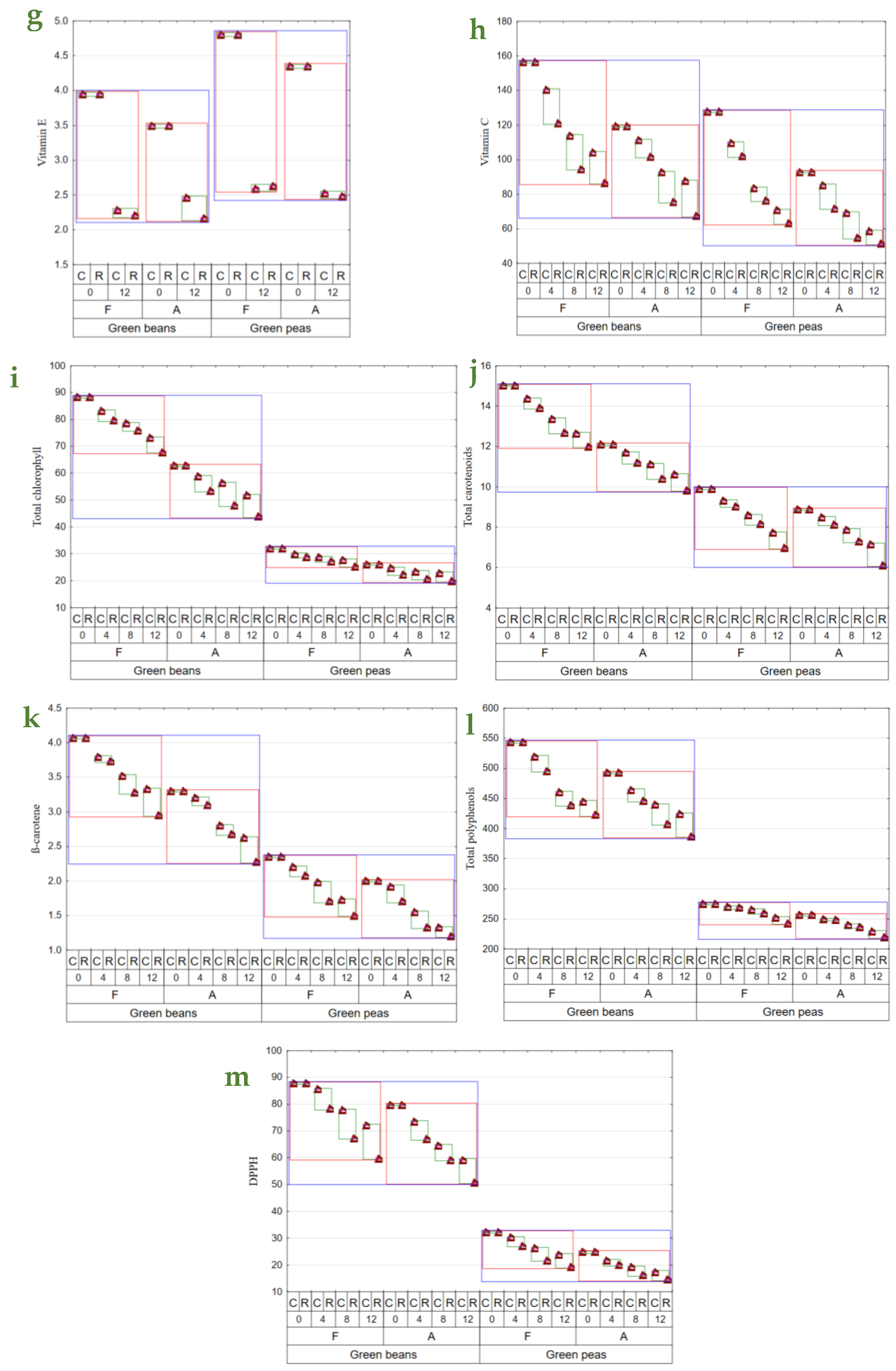

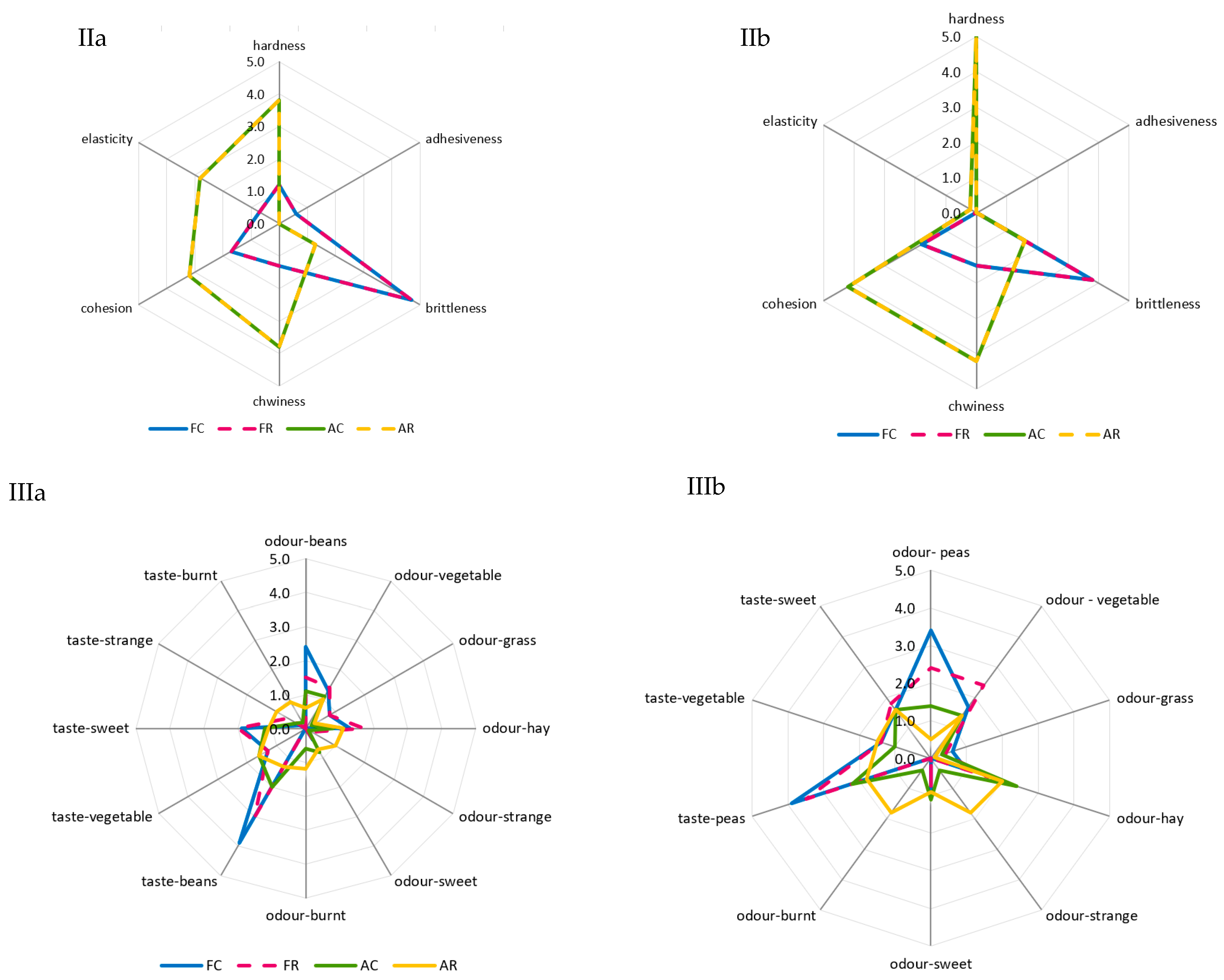

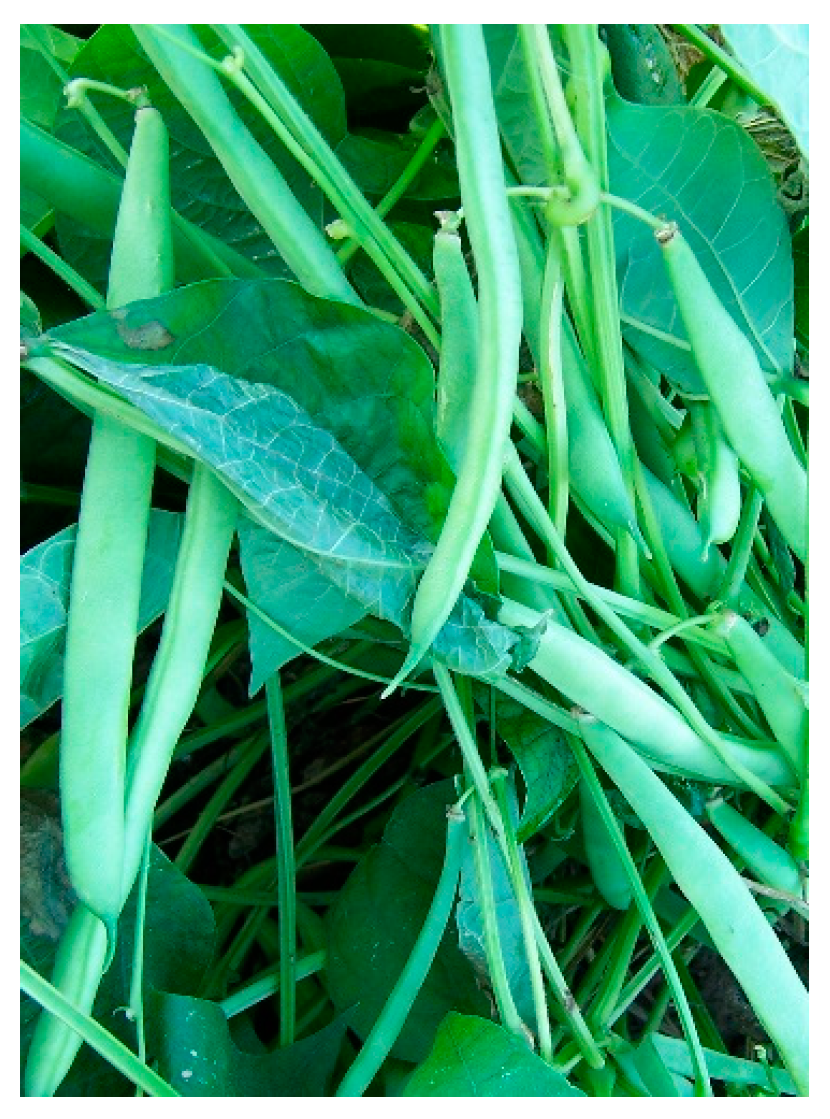
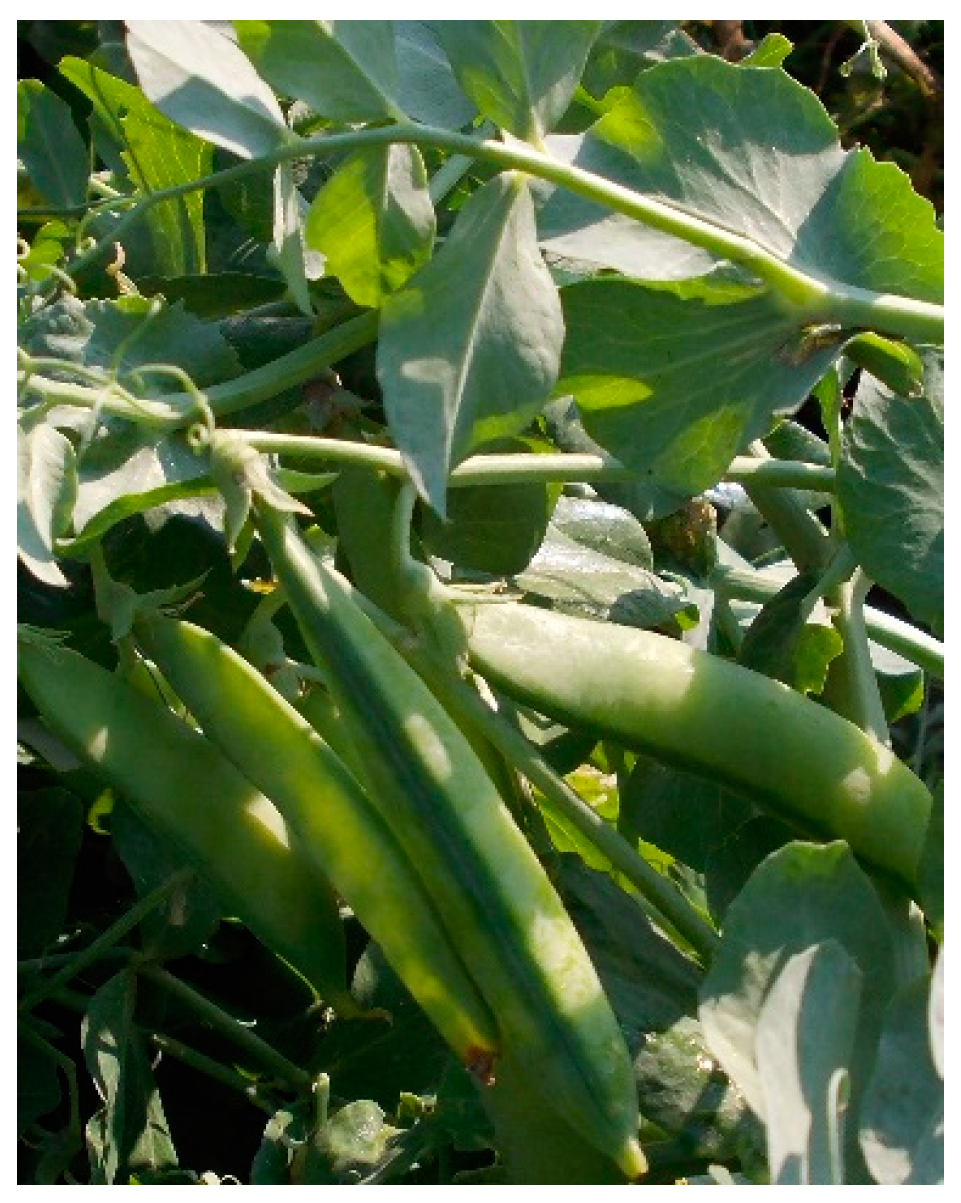

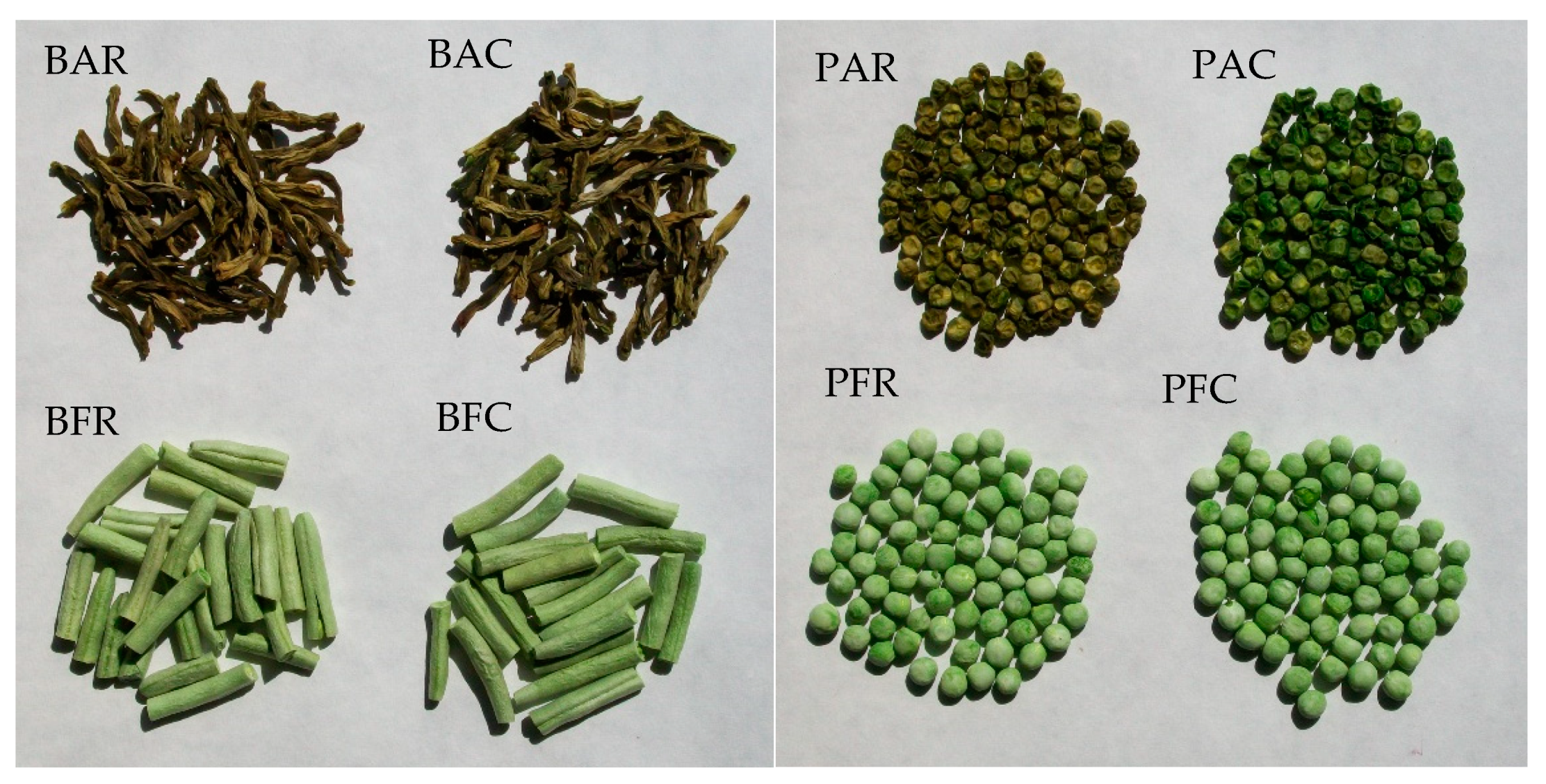
| Water Content [g] | L | a* | b* | Vitamin C [mg] | Vitamin E [mg] | Total Chlorophyll [mg] | Total Carotenoid [mg] | β-Carotene [mg] | Total Polyphenols [mg (+) Catechin] | DPPH [μmol Trolox Equivalent] | |
|---|---|---|---|---|---|---|---|---|---|---|---|
| 100 g f.w. | 100 g d.w. | 1 g d.w. | |||||||||
| Vegetable | |||||||||||
| Green beans | 91.26 ± 0.13 b | 55.81 ± 1.48 a | −8.98 ± 0.48 a | 17.24 ± 0.54 a | 174.63 ± 5.89 b | 4.07 ± 0.04 a | 96.63 ± 2.87 b | 15.39 ± 0.10 b | 4.30 ± 0.05 b | 532.13 ± 6.98 b | 91.88 ± 1.20 b |
| Green peas | 81.02 ± 0.22 a | 71.07 ± 1.47 b | −9.43 ± 0.21 a | 29.01 ± 0.60 b | 151.38 ± 5.51 a | 5.04 ± 0.05 b | 35.25 ± 0.87 a | 10.26 ± 0.11 a | 2.50 ± 0.03 a | 290.25 ± 4.04 a | 36.88 ± 1.17 a |
| Pre-treatment | |||||||||||
| Raw | 86.15 ± 1.98 a | 66.01 ± 2.75 b | −10.05 ± 0.2 b | 22.20 ± 2.29 a | 177.25 ± 5.14 b | 4.64 ± 0.19 b | 70.41 ± 12.56 b | 12.79 ± 0.96 a | 3.44 ± 0.35 a | 406.75 ± 42.38 a | 67.00 ± 10.41 b |
| Blanched | 86.13 ± 1.91 a | 60.87 ± 3.40 a | −8.36 ± 0.21 a | 24.05 ± 2.25 b | 149.75 ± 4.47 a | 4.47 ± 0.17 a | 61.46 ± 10.70 a | 12.86 ± 0.99 a | 3.36 ± 0.34 a | 415.63 ± 49.42 a | 61.75 ± 10.41 a |
| Water Content [g] | aw | Vitamin C [mg] | Total Chlorophyll [mg] | Total Carotenoid [mg] | β-Carotene [mg] | Total Polyphenols [mg (+) Catechin] | DPPH [μmol Trolox Equivalent] | |
|---|---|---|---|---|---|---|---|---|
| 100 g f.w. | 100 g d.w. | 1 g d.w. | ||||||
| Vegetable | ||||||||
| Green beans | 6.36 ± 0.43 a | 0.317 ± 0.032 a | 109.23 ± 3.23 b | 67.02 ± 1.77 b | 12.38 ± 0.20 b | 3.25 ± 0.06 b | 463.78 ± 5.91 b | 71.86 ± 1.39 b |
| Green peas | 6.37 ± 0.45 a | 0.461 ± 0.026 b | 83.56 ± 2.95 a | 26.10 ± 0.46 a | 8.27 ± 0.13 a | 1.81 ± 0.05 a | 252.56 ± 2.17 a | 23.25 ± 0.68 a |
| Drying method | ||||||||
| Freez-dried | 2.87 ± 0.02 a | 0.160 ± 0.012 a | 108.41 ± 3.54 b | 54.14 ± 3.24 b | 11.16 ± 0.34 b | 2.79 ± 0.11 b | 373.41 ± 14.53 b | 51.84 ± 3.32 b |
| Air-dried | 9.87 ± 0.02 b | 0.618 ± 0.007 b | 84.39 ± 2.69 a | 38.98 ± 2.08 a | 9.48 ± 0.23 a | 2.27 ± 0.09 a | 342.94 ± 13.24 a | 43.28 ± 3.10 a |
| Storage period [month] | ||||||||
| 0 | 6.30 ± 0.63 a | 0.383 ± 0.043 a | 124.06 ± 4.16 d | 52.29 ± 4.50 d | 11.48 ± 0.43 d | 2.93 ± 0.15 d | 391.69 ± 22.98 d | 56.13 ± 5.02 d |
| 4 | 6.36 ± 0.63 ab | 0.386 ± 0.043 a | 105.34 ± 3.61 c | 47.58 ± 4.16 c | 10.76 ± 0.41 c | 2.72 ± 0.14 c | 370.06 ± 20.46 c | 50.44 ± 4.72 c |
| 8 | 6.40 ± 0.63 b | 0.392 ± 0.044 a | 82.56 ± 3.09 b | 44.83 ± 3.95 b | 9.93 ± 0.39 b | 2.35 ± 0.14 b | 343.28 ± 17.06 b | 44.03 ± 4.28 b |
| 12 | 6.43 ± 0.63 b | 0.395 ± 0.044 a | 73.63 ± 3.01 a | 41.52 ± 3.53 a | 9.13 ± 0.42 a | 2.12 ± 0.14 a | 327.66 ± 16.87 a | 39.66 ± 3.90 a |
| Storage temperature [°C] | ||||||||
| 2–4 | 6.36 ± 0.44 a | 0.387 ± 0.030 a | 101.47 ± 3.29 b | 48.00 ± 2.91 b | 10.55 ± 0.30 b | 2.61 ± 0.10 b | 364.03 ± 14.33 b | 49.77 ± 3.32 b |
| 18–22 | 6.38 ± 0.44 a | 0.391 ± 0.031 a | 91.33 ± 3.57 a | 45.11 ± 2.85 a | 10.09 ± 0.31 a | 2.45 ± 0.11 a | 352.31 ± 13.68 a | 45.36 ± 3.16 a |
| Water Absorption [mL] | L | a* | b* | Vitamin E [mg] | |
|---|---|---|---|---|---|
| 100 g d.w | 100 g d.w. | ||||
| Vegetable | |||||
| Green beans | 694.69 ± 25.24 b | 63.97 ± 1.50 a | −2.67 ± 0.56 a | 3.08 ± 0.48 a | 3.00 ± 0.13 a |
| Green peas | 330.53 ± 15.15 a | 74.19 ± 0.58 b | −5.92 ± 0.39 b | 30.07 ± 0.85 b | 3.57 ± 0.18 b |
| Drying method | |||||
| Freez-dried | 620.78 ± 38.07 b | 73.41 ± 0.84 b | −6.68 ± 0.33 b | 16.14 ± 2.00 a | 3.40 ± 0.19 b |
| Air-dried | 404.44 ± 28.30 a | 64.75 ± 1.53 a | −1.90 ± 0.40 a | 17.02 ± 2.95 b | 3.16 ± 0.15 a |
| Storage period | |||||
| 0 | 534.50 ± 40.45 b | 66.63 ± 1.43 a | −5.23 ± 0.55 a | 17.63 ± 2.51 b | 4.15 ± 0.09 b |
| 12 | 490.72 ± 36.58 a | 71.53 ± 1.36 b | −3.35 ± 0.53 b | 15.52 ± 2.52 a | 2.41 ± 0.03 a |
| Storage temperature | |||||
| 2–4 | 518.22 ± 38.85 b | 68.45 ± 1.39 a | −4.50 ± 0.56 b | 16.24 ± 2.50 b | 3.30 ± 0.16 b |
| 18–22 | 507.00 ± 38.65 a | 69.72 ± 1.51 b | −4.08 ± 0.57 a | 16.92 ± 2.58 a | 3.26 ± 0.17 a |
Disclaimer/Publisher’s Note: The statements, opinions and data contained in all publications are solely those of the individual author(s) and contributor(s) and not of MDPI and/or the editor(s). MDPI and/or the editor(s) disclaim responsibility for any injury to people or property resulting from any ideas, methods, instructions or products referred to in the content. |
© 2024 by the authors. Licensee MDPI, Basel, Switzerland. This article is an open access article distributed under the terms and conditions of the Creative Commons Attribution (CC BY) license (https://creativecommons.org/licenses/by/4.0/).
Share and Cite
Gębczyński, P.; Tabaszewska, M.; Kur, K.; Zbylut-Górska, M.; Słupski, J. Effect of the Drying Method and Storage Conditions on the Quality and Content of Selected Bioactive Compounds of Green Legume Vegetables. Molecules 2024, 29, 1732. https://doi.org/10.3390/molecules29081732
Gębczyński P, Tabaszewska M, Kur K, Zbylut-Górska M, Słupski J. Effect of the Drying Method and Storage Conditions on the Quality and Content of Selected Bioactive Compounds of Green Legume Vegetables. Molecules. 2024; 29(8):1732. https://doi.org/10.3390/molecules29081732
Chicago/Turabian StyleGębczyński, Piotr, Małgorzata Tabaszewska, Katarzyna Kur, Maria Zbylut-Górska, and Jacek Słupski. 2024. "Effect of the Drying Method and Storage Conditions on the Quality and Content of Selected Bioactive Compounds of Green Legume Vegetables" Molecules 29, no. 8: 1732. https://doi.org/10.3390/molecules29081732
APA StyleGębczyński, P., Tabaszewska, M., Kur, K., Zbylut-Górska, M., & Słupski, J. (2024). Effect of the Drying Method and Storage Conditions on the Quality and Content of Selected Bioactive Compounds of Green Legume Vegetables. Molecules, 29(8), 1732. https://doi.org/10.3390/molecules29081732






